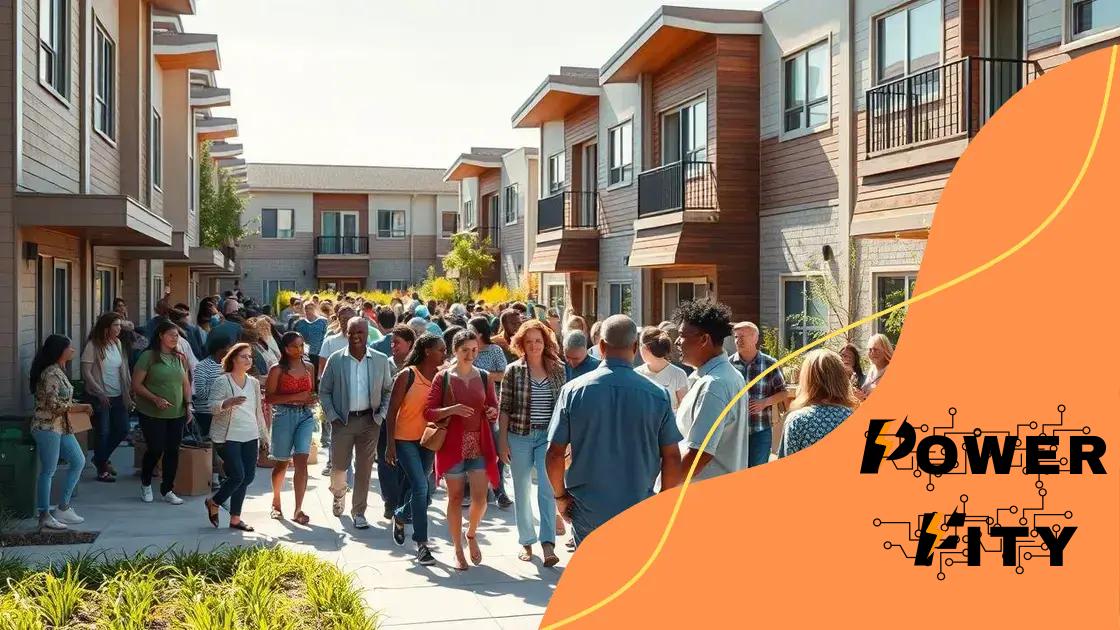Expanding access to affordable housing under new federal policies

Expanding access to affordable housing under new federal policies involves innovative solutions, community involvement, and public-private partnerships, addressing financial challenges while fostering diverse and inclusive neighborhoods.
Expanding access to affordable housing under new federal policies is a hot topic that impacts many lives. Have you ever wondered how these changes could affect your community? Let’s dive into the details together.
Understanding the new federal housing policies
Understanding the new federal housing policies can be challenging but is essential for navigating today’s housing landscape. These policies aim to increase affordable housing availability for families in need, impacting communities nationwide.
What Are the Key Features?
The recent policies introduced by the federal government include several important features. Each aspect focuses on creating a sustainable housing market and promoting accessibility.
- Increased funding for affordable housing projects
- Tax incentives for developers who build low-income housing
- Stronger protections for renters to prevent eviction
- Support for first-time homebuyers through grants and assistance programs
As these policies roll out, they bring hope to many who struggle to find decent homes. The emphasis on inclusivity means that more voices are being heard in the planning process, ensuring that the needs of various communities are met.
Challenges in Implementation
Despite the positive intentions, implementing these policies can be complex. Local governments often face hurdles such as funding discrepancies, community opposition, and zoning laws that can hinder progress. It’s critical for advocates and community members to engage with policymakers to ensure that the benefits are realized.
Moreover, there is a need for education about these programs. Many individuals remain unaware of the resources available to them, which can lead to missed opportunities.
All in all, understanding these new federal housing policies is pivotal for anyone involved in housing, whether as a potential homeowner, a renter, or a community organizer. As we move forward, remaining informed is key to tapping into the benefits that these changes can bring.
Key benefits of affordable housing access
Understanding the key benefits of affordable housing access is vital for individuals and families. Affordable housing plays a crucial role in improving lives by providing stability and security.
Enhanced Financial Stability
When families can find affordable homes, they can allocate more of their income to other essential needs. Instead of spending a large portion of their budget on housing, they can invest in education, healthcare, and savings. This shift leads to improved overall well-being for many households.
- Reduction in financial stress allows families to thrive
- Increased disposable income benefits local economies
- Ability to save for future goals
- Improved mental health due to reduced anxiety about housing costs
In addition, access to affordable housing can lead to better educational outcomes. When families are stable, children can focus more on their studies rather than worrying about moving or being displaced. Schools in stable communities tend to have stronger programs and resources.
Community Development
Affordable housing also enhances community development. As more people can afford to live in diverse neighborhoods, communities become richer in culture and social interaction. This diversity fosters a sense of belonging and encourages local involvement.
Moreover, communities with access to affordable housing can become more resilient. A stronger community can advocate for better services and infrastructure, creating an environment that supports everyone.
The benefits of affordable housing extend beyond individual families to society as well. When people have stable housing, they are more likely to engage in their communities, volunteer, and participate in local events.
Challenges in implementing these policies

The challenges in implementing these policies can be significant. Although the goals of new housing policies are clear, achieving them is often a complex process that involves many stakeholders.
Funding and Budget Constraints
A major challenge is securing sufficient funding. Many local governments may struggle to allocate enough resources to these initiatives. Budgets can be tight, and competing priorities may limit what can be invested in affordable housing projects. This can result in delays or scaling back of planned developments.
- Limited government budgets restrict project funding
- Increased construction costs make affordability tougher
- Dependency on grants that may not always be available
Additionally, bureaucratic hurdles can slow down the process. Navigating complex regulations and obtaining necessary permits can deter developers, leading to a lack of new affordable housing units. This results in frustration for many who need housing solutions now.
Community Opposition
Another considerable barrier is community opposition. Sometimes, local residents may resist new affordable housing developments due to concerns about property values or changes in neighborhood dynamics. Engaging with community members early and addressing their concerns can help alleviate these fears, but it takes time and effort.
Moreover, misconceptions about affordable housing can contribute to this opposition. Some people believe that affordable housing attracts crime or lowers the quality of life in a neighborhood. Therefore, educating communities about the benefits of affordable housing is essential to facilitate smoother implementation.
The successful implementation of these policies often relies on building coalitions among local governments, developers, and community organizations. Without collaboration, tackling these challenges becomes even more difficult.
Real-life success stories in affordable housing
Real-life success stories in affordable housing demonstrate how policies can positively impact communities. These examples not only provide hope but also show that achievable solutions exist.
The Role of Nonprofits
Many nonprofit organizations have taken the lead in creating affordable housing. One outstanding example is Habitat for Humanity, which builds homes for families in need. Their model involves community volunteers and sweat equity, allowing families to put in work to earn their homes.
- Partnerships with local businesses enhance resources
- Utilizing donated materials reduces costs
- Empowering families through homeownership education
This model not only provides housing but also teaches valuable skills, fostering a sense of ownership and community among homeowners.
Success in Urban Areas
Cities across the country have implemented successful affordable housing projects. For instance, San Francisco’s inclusionary zoning laws require new developments to offer a percentage of affordable units. This has led to several mixed-income projects that blend affordability with market-rate housing.
These projects create diverse neighborhoods and provide lower-income families with access to better resources, such as schools and transportation. Many of these new developments include parks and community spaces, making them desirable places to live.
Furthermore, success stories often involve collaboration between government agencies and private developers. For example, in Chicago, the city partnered with developers to revitalize entire neighborhoods. These partnerships leverage public funds and private investment to create thriving communities.
Future outlook on housing accessibility
The future outlook on housing accessibility is promising, with ongoing efforts aimed at creating more equitable living conditions. As governments and organizations recognize the need for change, they are increasingly prioritizing affordable housing initiatives.
Innovative Solutions
One key aspect of this future is the introduction of innovative solutions in housing design and construction. Technologies such as 3D printing and modular homes are changing the way we approach building affordable housing. These methods can reduce costs and construction times, making it easier to bring new units online quickly.
- 3D printing can allow for rapid construction of homes
- Modular designs enable flexible and scalable housing solutions
- Sustainable materials improve overall efficiency
Furthermore, cities are beginning to adopt more inclusive zoning laws that require a portion of new developments to be affordable. This shift means that as urban areas grow, they will integrate affordable units alongside market-rate options. This approach helps mitigate the issue of displacement and fosters diverse communities.
Community Involvement
Another trend is increased community involvement in the decision-making process regarding housing projects. Residents are becoming active participants in shaping their neighborhoods. By voicing their needs and concerns, communities can ensure that new developments meet the requirements of all residents.
Additionally, public-private partnerships are expected to expand, allowing resources to be pooled for larger projects. These collaborations can lead to the development of comprehensive housing strategies that address various community needs.
With a commitment to addressing barriers, the future may see enhanced accessibility through policy reforms and community engagement. Overall, the push for housing accessibility signals a significant step toward a more equitable society.
In conclusion, the journey towards affordable housing accessibility is filled with challenges and opportunities. As we look ahead, innovative solutions and strong community involvement will play crucial roles in shaping housing policies. By prioritizing collaboration and education, we can build diverse neighborhoods that foster stability and growth. Together, we have the power to create a future where everyone has a place to call home.
FAQ – Frequently Asked Questions about Affordable Housing Accessibility
What are the main benefits of affordable housing?
Affordable housing provides financial stability, access to better education, and strengthens communities through diversity.
What challenges do cities face when implementing new housing policies?
Cities often encounter funding shortages, bureaucratic hurdles, and community opposition to new affordable housing developments.
How can technology improve affordable housing solutions?
Innovative technologies like 3D printing and modular construction can streamline building processes and reduce costs.
Why is community involvement important in housing policy decisions?
Community involvement ensures that housing projects meet the actual needs of residents, leading to better outcomes and acceptance.





